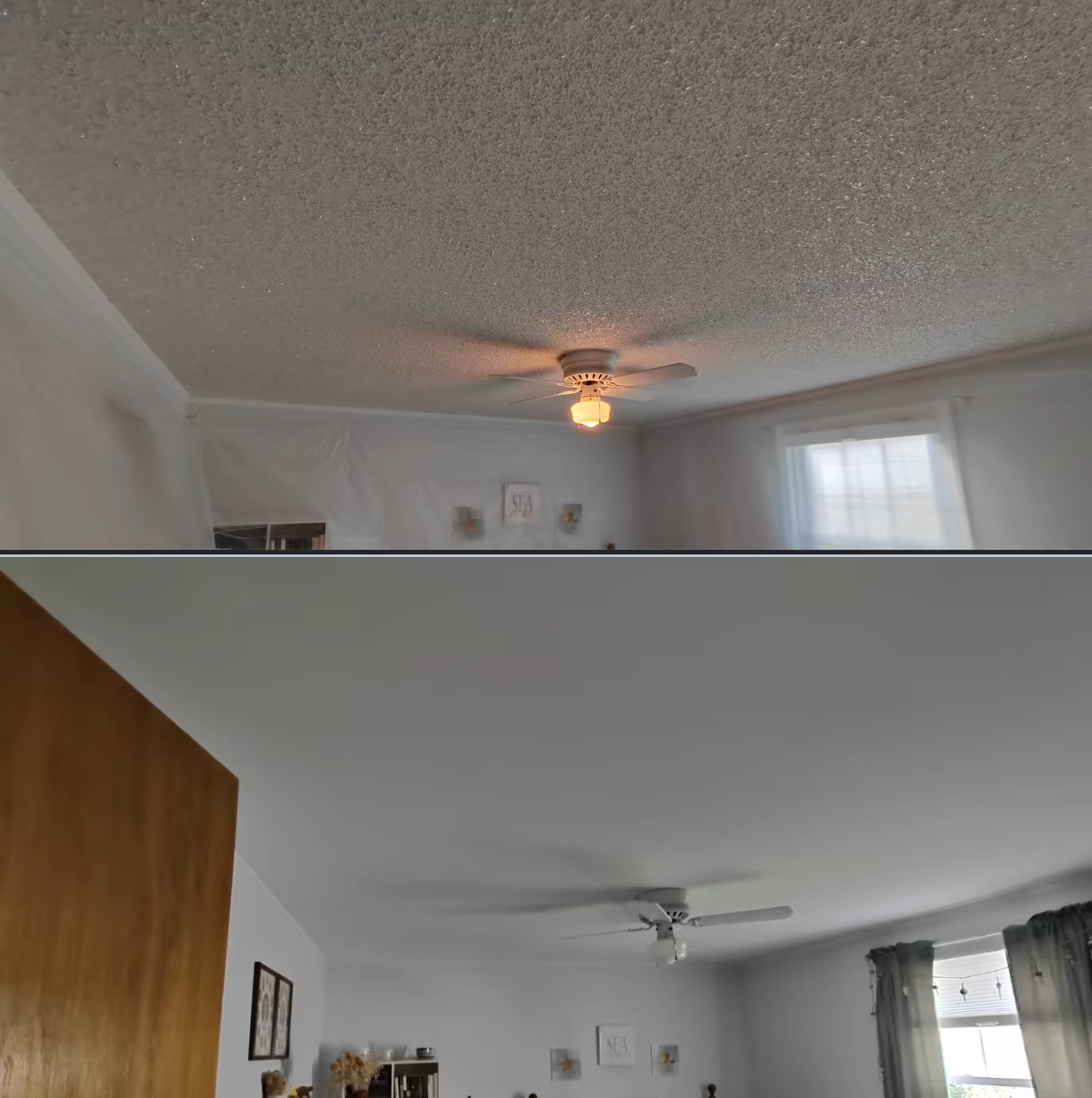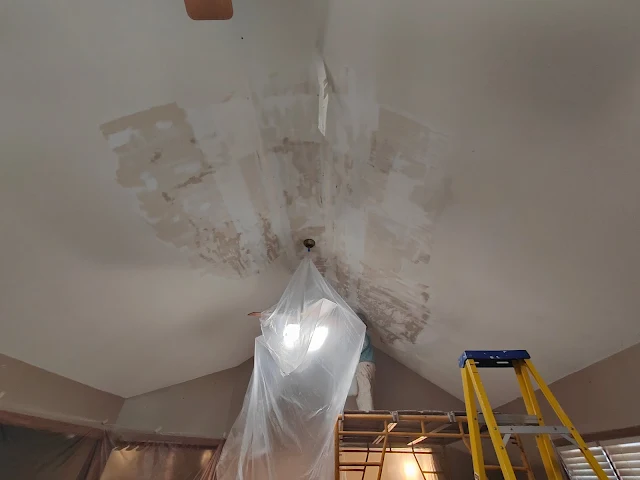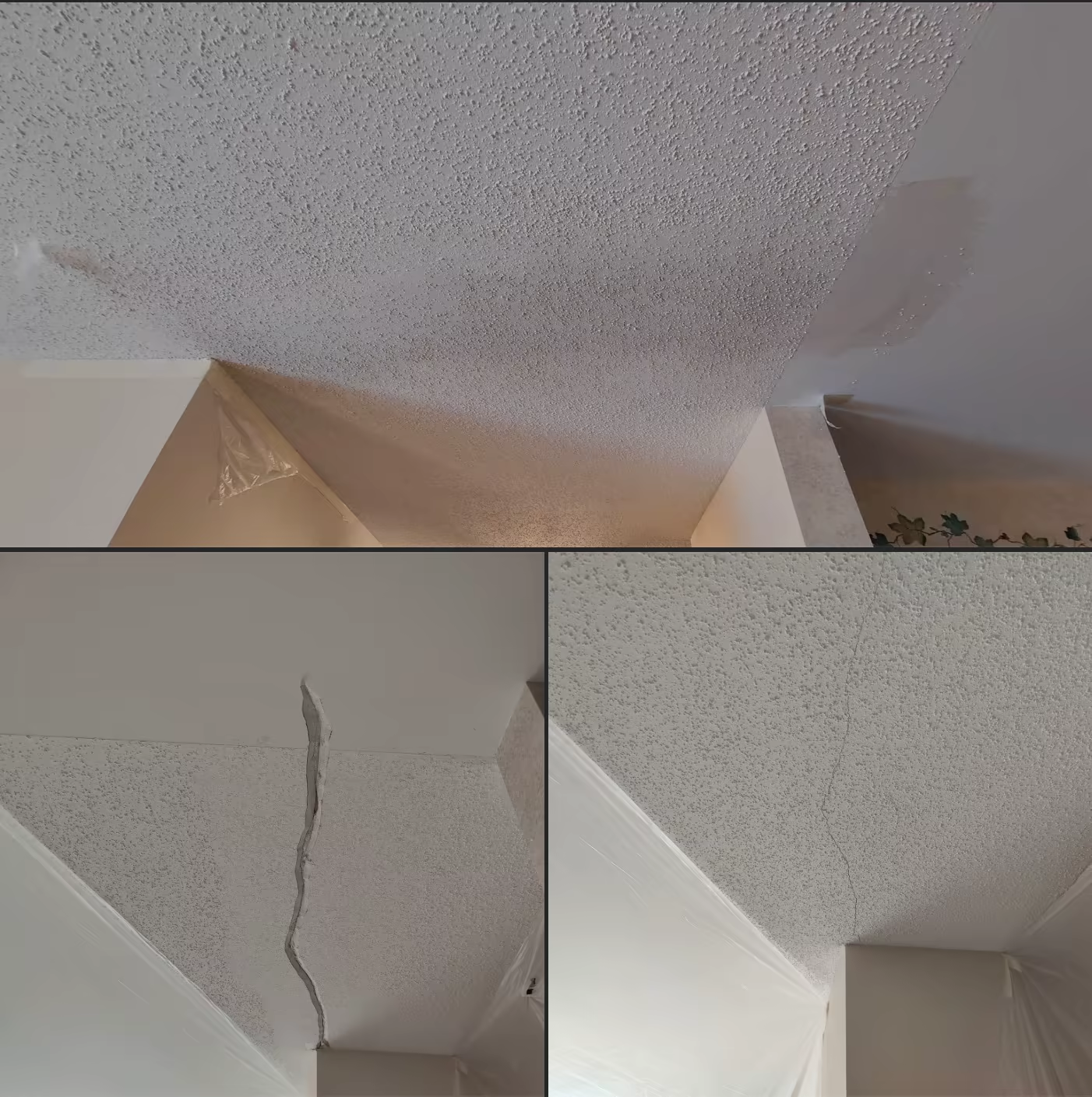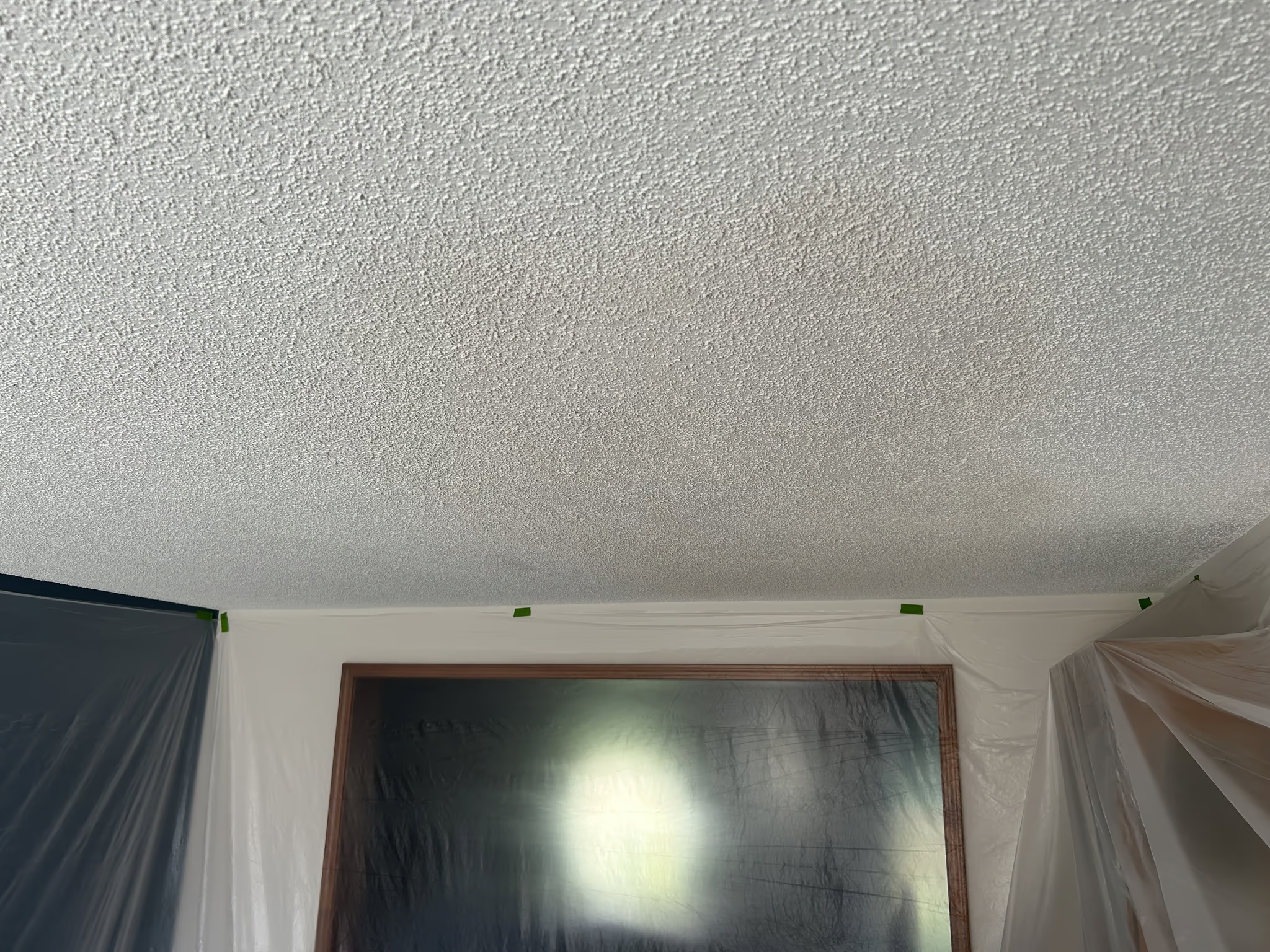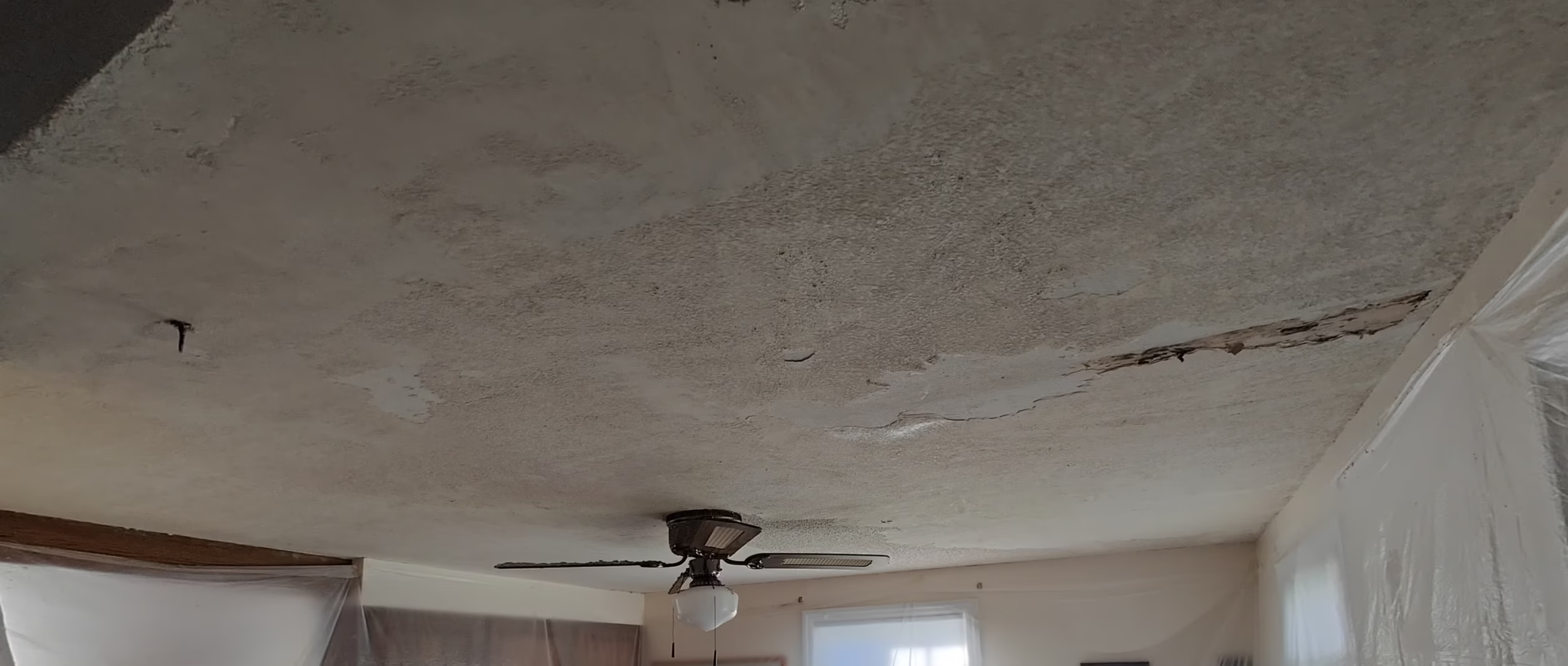Popcorn Texture Removal
Buffalo NY
Welcome to Carrigan Painting, a locally owned small business proudly serving the northern suburbs of Buffalo NY. With over 15 years of 5-star reviews and a proven track record of successful projects, we specialize in delivering beautifully smooth ceilings, often in just a few days. Popcorn ceiling removal is one of the messiest and most difficult jobs a homeowner can attempt. That’s why it makes sense to hire professionals with years of experience and dozens of completed ceilings across WNY. Skip the mess, and let us handle it.
Carrigan Painting
The Cost of Removing Popcorn Ceiling and Painting
A lot goes into figuring out the cost to remove a popcorn ceiling. Our removal projects are usually between $10 - $14 per square foot, its important for potential clients to understand the process to better understand the costs involved.
There are no ballpark estimates. Pictures can hide a lot. Its best to get eyes on the work. While everyone claims to not hold contractors to a ball park price, we all do. Its human nature. Which is why we don’t give ball park prices.
What follows are questions that will be answered during the estimate
1) Where are you located? Whats the parking situation? Driveway access?
We work exclusively in the suburbs of Buffalo NY.
2) Where is the job located? Living room on the first floor with 8’ ceilings? Or is it the bedroom on the 3rd floor with 10-12’ ceilings? Maybe the great room or foyer with 18’ ceilings?
Ceiling height plays a big part in the removal of popcorn ceilings. Up and down a ladder 500x, the risk of getting hurt goes up exponentially due to the slippery-ness of wet popcorn texture on the bottom of your feet. The setting up, and taking down of scaffolding and equipment also plays a role.
3) What is the floor situation? Carpet? Hardwood? Tile? Marble? Even though we are working on the ceiling, we are literally working on the floor. For instance, a tile or marble floor will need much more robust protection than carpet.
4) Has the popcorn ceiling been painted? This is a BIG question and will directly affect pricing. Painted popcorn ceilings can be EXTREMELY difficult to remove, as the popcorn has been essentially sealed into the ceiling. Paint, is not made to come off. Add popcorn…
- A painted popcorn ceiling will not come off cleanly in most cases, and will require the ceiling to be primed, skim coated, primed again, then painted. Depending on the size of the ceiling, that can be quite involved. Often times, a painted popcorn ceiling will leave excess material behind. Its very rough. We prime it, and then skim over it. The issue is that some times, this ‘base layer’ (for lack of a better term) will peal in spots from the primer, leading to more patching.
Get your Free Popcorn Ceiling Removal Quote
5) How BIG is the ceiling?
-We do not give a discount on more ceilings to remove. The removal of popcorn, is the most labor intensive part of the painting industry. There are no bulk discounts. If we are bidding on removing popcorn from the living room ceiling, we do not discount the removal of popcorn from the dining room ceiling. The amount of work is similar per ceiling, just the duration is different.
6) Drywall or plaster? This is important to know, due to the fact that water and drywall do not play well together. Plaster and water doesn’t either, however because plaster is so much harder than drywall, removing popcorn from a plaster ceiling, is usually easier than removing popcorn from a drywall ceiling.
7) Are you painting the walls? Serious question. Often with popcorn removal, the top corner of the walls near the ceiling, will sometimes incur damage.
8) Can we keep the space ‘set up’ over night / through out the job? Popcorn removal requires the extensive set up and clean up, which can take 60-90 minutes per day to set up & clean up. If we are removing it every night and setting everything back up the next day, that will affect the cost of the job.
9) Have you tested the ceiling for asbestos? Ceilings that test positive for asbestos, cost more to remove.
Popcorn removal is EXTREMELY messy and dirty. We remove it wet. It sticks to everything, especially our feet! We track it everywhere. After the job is complete, ladders, scaffolding, planks ect. often require cleaning prior to the start of the next job.
-There is also a considerable amount of dust that is created with popcorn removal due to skim coating requirements. While we do our best to contain the dust, it can and will travel, everywhere! We do clean up daily, and as we go, due to how messy popcorn can be.
In most scenarios, it costs around $10 a square foot. With out seeing the job itself, every painting contractor will give you a very high estimate as to the costs associated with removal. To get the most accurate costs associated with removal, its best to give us a call. Our removal quotes are free, and our schedule is pretty flexible.
Get your Free Popcorn Ceiling Removal Quote
Steps for Popcorn Ceiling Removal
Call today to get a free quote for popcorn ceiling removal or repair in Amherst, Clarence, Lancaster and surrounding suburbs.
-
Day 1:
- 1. Cover everything from floor to Ceiling
- 2. Spray the ceiling with water
- 3. Scrape the popcorn off the ceiling
- 4. Clean up. A full clean up Day 2:
- 5. Set everything back up again, pole sand the ceiling, prime Ceiling
- 6. Skim coat ceiling
- 7. Clean up Day 3:
- 8. Set everything back up again, sand ceiling, patch ceiling, spot prime
- 9. paint ceiling.
- 10. Clean up.
Takes a lot of time.
The average room takes about 3 days to complete. The ceiling must fully dry between steps. Any attempts to rush the process with fans has always resulted in failure. Such as the primer peals off in sheets, the compound potmarks with bubbles or has other adhesion issues.
The Dusty Truth about Popcorn Removal
Scraping off popcorn ceilings, in our experience can go one of two ways. Easy off, or doesn’t come off. Usually the latter. Also in every case where we have scraped the ceilings, it needed to be skim coated. Some times more than once.
The issue here is 75% of the time, the ceiling isn’t even primed under the popcorn – its just bare drywall, which means the ceilings haven’t been finished! So in order to get them ready to be painted instead of being textured, the ceilings need to be finished.
But because ceilings often incur minor damage in the course of the texture removal, its easier, faster and cheaper to just skim the entire ceiling – with the added benefit of making the ceilings smoother instead of 50 patches everywhere.
Also it is not uncommon to have to address issues that were masked by the texture or other more significant damage that wasn’t apparent before. Its not really a problem, just adds more cost to the job. It takes an experienced eye to spot damage hidden by popcorn.
During all of this, is the most dust and dirt that you have ever seen, or will see in your house at any one point. Which we are constantly cleaning up, going through a lot of materials in the form of floor protection, wall protection, and dust containment. All the while your family must still live in the home.
Once the popcorn is off, the ceiling must be dry enough to prime it which will seal the surface of the drywall (can be bad if the ceiling isn’t adequately dry prior to priming).
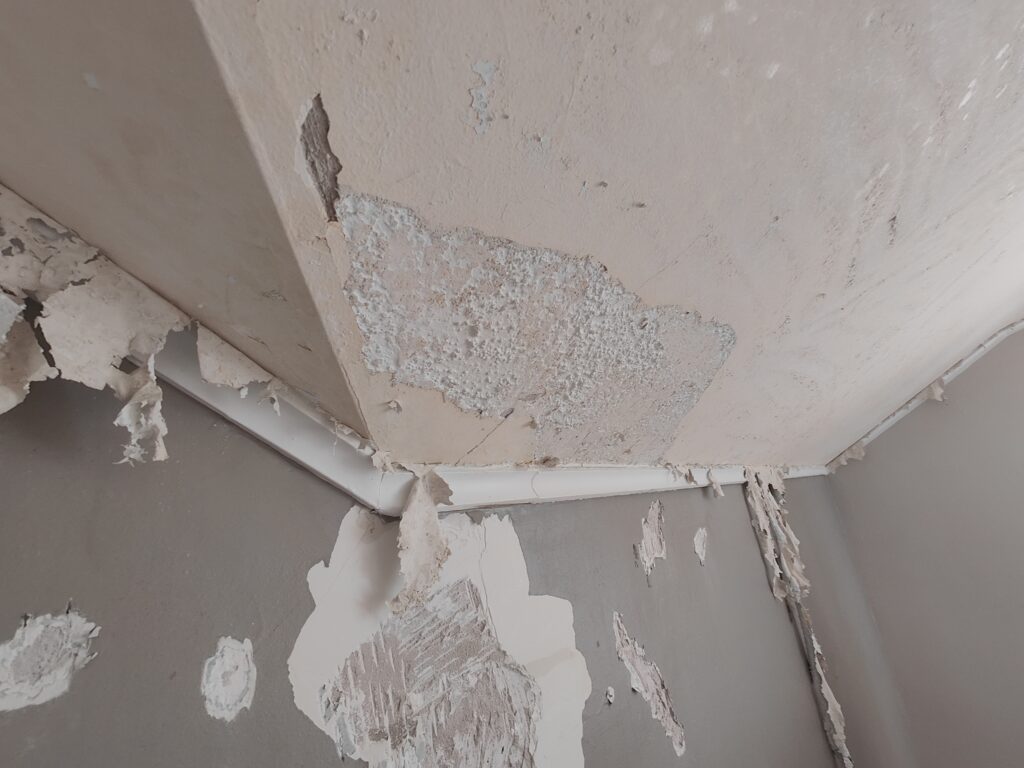
This damage was effectively hidden by the texture
Popcorn Ceiling Removal in the suburbs of Buffalo
How we repair a Popcorn Ceiling
Applying popcorn ceiling texture demands specialized equipment that many painting contractors are hesitant to acquire. It also necessitates significant upper body strength to manage the hopper without spilling it all on the floor! Popcorn ceiling texture has the consistency of watery oatmeal, so it splatters easily, sticks to everything, and is overall very messy.
If you recently had plumbing work done, or suffered other damage to your popcorn ceilings, we can make the needed repairs, spray popcorn, then paint the ceiling.
Repairing popcorn ceilings is pretty straight-forward, just requires a couple of extra steps. We remove the existing popcorn around the damage to ensure our patches are as smooth and flat as possible. Then we spot prime our patches. Once we are happy with our patchwork, its primed, we require the use of a 20amp outlet for our air compressor (which stays in the truck, its heavy and very noisy). We run airhoses and spray the new texture. As soon as the texture is sprayed, we clean up everything. The ceiling must dry before we can paint it, usually about a day.
Typically, it takes 1-2 hours to set up to spray popcorn, 10-15 minutes to spray popcorn, and then an hour or so to clean up
Often times, a new water stain will appear with in a day or two around the newly sprayed texture. This is normal. The moisture in the fresh texture disturbs the dust on the existing texture creating a brown stain. We spot prime the new texture with oil based primer, then paint the ceiling with a high quality latex ceiling paint to ensure a uniform color, sheen, and texture.
Painted ceiling texture has a different texture than unpainted ceiling texture.
Get your Free Popcorn Ceiling Repair Estimate Today!
Depending on the size of the repair, priming the patches / ceiling, and painting the same, may take more than one day. The reason for this is due to the nature of popcorn. Once it becomes saturated, it will peal off the ceiling. Which is why every step must thoroughly dry before moving to the next step. There is no rushing the process.
A popcorn ceiling repair we did back in November 2023 in Lancaster NY, with lots of photos of the process.
Can Popcorn Ceilings be painted?
Yes! We paint popcorn ceilings all the time. A lot of painting contractors prefer not to paint popcorn ceilings due to the extra work and costs involved. For one, it ruins the roller cover. Also requires more prep, its messy, as it rains popcorn when we roll it. It also requires about 50% more paint.
It can take twice as long to paint a popcorn ceiling vs a smooth ceiling!
The 'cut in' or edging as some call it, must fully dry prior to rolling paint on the ceiling. Which can add significant time to the job. When we roll the ceiling, we roll into the 'cut in', we run the risk of pealing the popcorn off the ceiling (bad). If its fully dry, this typically wont happen. If its at all wet or damp, it can and will peal! We will often run lots of fans to speed up drying, however we are limited due to the plastic blowing around.
When we roll paint on a popcorn ceiling, some of the texture does come off in the form of small white gobs that sticks to everything. Its messy. You can clearly tell who rolled the ceiling. For this reason, we ask that the homeowner limit their incursion into the work area as much as possible during the painting process.
Get Your Free Popcorn Ceiling Painting Estimate Today!
Covering Popcorn Ceilings
Sometimes it may be easier, and possibly cheaper, to just go over the ceiling with new drywall. It needs to be noted that putting new drywall over an existing popcorn ceiling may not rid the ceiling of defects. Meaning that the waviness of the existing ceiling may be exacerbated with new drywall. This is especially true with plaster ceilings
We do not install new drywall ceilings at this time.
Popcorn Ceiling Specialists
Popcorn Ceiling Questions and Answers
Why is popcorn texture coming off while painting?:
If its coming off in sheets or large clumps its too wet. You need to stop painting!
We like to cut in the popcorn ceiling first, and then we wait about an hour, before we will roll the ceiling to give the cut in enough time to dry. Also, we limit our back rolling and limit our pattern to a smaller area at a time while taking care to limit over lap.
If its 'raining' popcorn, welcome to popcorn ceiling painting. Thats why we cut in first, and then roll. Limits the amount of time we are walking in it.
How to touch up popcorn ceilings?
Popcorn Paint?
Popcorn texture in an aerosol can you buy at the big box stores, is garbage. How we loathe that crap. It really is. Like expecting oatmeal and getting cream of wheat. Its that bad! First, You can shake it til your arm falls off, will not thicken it. It needs to be watery to get out of the can. The other problem is that it dries extremely hard. Harder than paint. So in the future if you decide to strip the ceiling, that spot is going to be a real problem. It also has a sheen, whereas your ceiling is probably flat white.
Take 20 easy-sand drywall compound (white bag, blue lettering) mix up a little bit in a disposable cup, and using a crappy paint brush, lightly dab it onto the surface. Remember, a little texture is better than too much texture. A little goes a long way. We use 20, but any drywall compound you have on hand will work. Use a paint brush.
Do NOT wash anything out in a sink or anything with a drain. This material has a chemical set, and will go hard under water - permenantly clogging your pipes! Just throw the stuff out.
Unfortunately, you really can not duplicate the texture of popcorn, unless you do it the right way.
Work with the local expert.
Recent Popcorn Ceiling Projects near You!
For some reason some thumbnails wont load. Not sure why.


